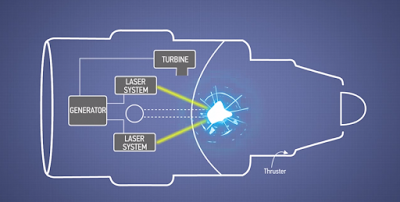Future aircraft could be powered by lasers and nuclear explosions if Boeing has its way. The aerospace firm claims a new-type of engine could produce energy-efficient thrust by firing lasers at radioactive material, such as deuterium and tritium. The technology could mean that planes and spaceships will require only a fraction of the power to operate, according to a recent patent filed by the company.
The engine outlined in the patent would work by using high-powered lasers to vaporize the radioactive material producing a fusion reaction.
'At least one laser is positioned to vaporizer the propellant with at least one laser-beam into a thrust producing flow,' the company wrote in the document.
The by-products of the process would be hydrogen or helium, which would leave the back-end of the plane creating thrust.
Meanwhile, the inside wall of the engine's thrust-er chamber will react with the neutrons created by the nuclear reaction.
The resulting heat can then be harnessed by placing a coolant on the sides of the combustion chamber.
The idea is to use this heat to produce electricity that can then drive the engine’s lasers.
Other than the radioactive material, the engine requires very little in terms of external energy.
Boeing’s Dreamliner is currently driven by turbofan engines that compress air and ignite fuel to create thrust.
But it's expensive. The 787-8 Dreamliner. for instance, uses roughly $24.53 (£15.97) worth of fuel per nautical mile flown
The latest application, approved by the US Patent and Trademark Office last week, was filed by Boeing's Robert Budica, James Herzberg, and Frank Chandler.
It is unclear when, if ever, Boeing plans to create a prototype of the engine.
But it isn't just the mechanics of the plane that Boeing is hoping to revolutionize.
In April, the company filed a patent for a bizarre 'upright' sleeping support system that could mean economy passengers can sleep on long-haul flights too.
Nicknamed the 'cuddle chair,' the somewhat comical idea could revolutionize the plane sleeping experience by eliminating the need for reclining seats at all.
It looks like a backpack and fastens to the back of the headrest to allow passengers to lean forward and rest their face and chest on the contraption.
According to the patent for the 'Transport Vehicle Upright Sleep Support System,' and illustrative animated video from website PatentYogi , the head cushion will have a 'face relief aperture,' which is essentially a face-front pillow with a hole for breathing.
A spokesperson for Boeing said at the time: 'We aren't providing any further information or comment beyond what was detailed in the patent filing.'
The engine outlined in the patent would work by using high-powered lasers to vaporize the radioactive material producing a fusion reaction.
'At least one laser is positioned to vaporizer the propellant with at least one laser-beam into a thrust producing flow,' the company wrote in the document.
The by-products of the process would be hydrogen or helium, which would leave the back-end of the plane creating thrust.
Meanwhile, the inside wall of the engine's thrust-er chamber will react with the neutrons created by the nuclear reaction.
 |
| Boeing Nuclear Laser Engine |
The resulting heat can then be harnessed by placing a coolant on the sides of the combustion chamber.
The idea is to use this heat to produce electricity that can then drive the engine’s lasers.
Other than the radioactive material, the engine requires very little in terms of external energy.
Boeing’s Dreamliner is currently driven by turbofan engines that compress air and ignite fuel to create thrust.
But it's expensive. The 787-8 Dreamliner. for instance, uses roughly $24.53 (£15.97) worth of fuel per nautical mile flown
The latest application, approved by the US Patent and Trademark Office last week, was filed by Boeing's Robert Budica, James Herzberg, and Frank Chandler.
It is unclear when, if ever, Boeing plans to create a prototype of the engine.
But it isn't just the mechanics of the plane that Boeing is hoping to revolutionize.
In April, the company filed a patent for a bizarre 'upright' sleeping support system that could mean economy passengers can sleep on long-haul flights too.
Nicknamed the 'cuddle chair,' the somewhat comical idea could revolutionize the plane sleeping experience by eliminating the need for reclining seats at all.
It looks like a backpack and fastens to the back of the headrest to allow passengers to lean forward and rest their face and chest on the contraption.
According to the patent for the 'Transport Vehicle Upright Sleep Support System,' and illustrative animated video from website PatentYogi , the head cushion will have a 'face relief aperture,' which is essentially a face-front pillow with a hole for breathing.
A spokesperson for Boeing said at the time: 'We aren't providing any further information or comment beyond what was detailed in the patent filing.'




No comments:
Post a Comment